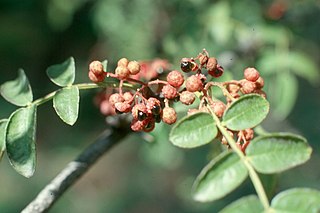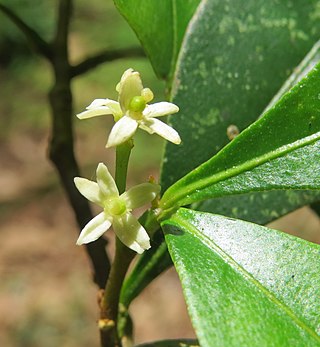
Zanthoxylum is a genus of about 250 species of deciduous and evergreen trees, shrubs and climbers in the family Rutaceae that are native to warm temperate and subtropical areas worldwide. It is the type genus of the tribe Zanthoxyleae in the subfamily Rutoideae. Several of the species have yellow heartwood, to which their generic name alludes. Several species are cultivated for their use as spices, notably including Sichuan pepper.

Zanthoxylum clava-herculis, the Hercules' club, Hercules-club, pepperwood, or southern prickly ash, is a spiny tree or shrub native to the southeastern United States. It grows to 10–17 m tall and has distinctive spined thick, corky lumps 2–3 cm long on the bark. The leaves are glabrous and leathery, pinnately compound, 20–30 cm long with 7-19 leaflets, each leaflet 4–5 cm long. The flowers are dioecious, in panicles up to 20 cm long, each flower small, 6–8 mm diameter, with 3-5 white petals. The fruit is a two-valved capsule 6 mm diameter with a rough surface, and containing several small black seeds. The tree has also been called Z. macrophyllum. The genus name is sometimes spelled Xanthoxylum.

Chloroxylon swietenia, the Ceylon satinwood or East Indian satinwood, is a tropical hardwood, the sole species in the genus Chloroxylon. It is native to southern India, Sri Lanka, and Madagascar.
Thomas Gordon Hartley was an American botanist.
Zanthoxylum mayu, synonym Fagara mayu, is a species of plant in the family Rutaceae. It is endemic to Chile. It is threatened by habitat loss.
Zanthoxylum mezoneurispinosum, synonym Fagara mezoneurispinosa, is a species of plant in the family Rutaceae. It is endemic to lowland tropical rainforests of Ivory Coast.
Zanthoxylum deremense is a species of plant in the family Rutaceae. It is found in Malawi and Tanzania.

Zanthoxylum caribaeum is a species of plant in the family Rutaceae. It is found in Belize, Guatemala, and Honduras.
Zanthoxylum spinosum subsp. hartii is a species of plant in the family Rutaceae. It is endemic to Jamaica.
Zanthoxylum holtzianum is a species of plant in the family Rutaceae. It is endemic to Tanzania.
Zanthoxylum lindense is a species of plant in the family Rutaceae. It is endemic to Tanzania.
Zanthoxylum juniperinum is a species of plant in the family Rutaceae. It is found in Belize, Costa Rica, Guatemala, Honduras, Mexico, Nicaragua, and Panama.

Zanthoxylum punctatum, also known as the St. Thomas prickly-ash, is a species of plant in the family Rutaceae. It is found in Puerto Rico, the British Virgin Islands, and the United States Virgin Islands. Its natural habitats are tropical and subtropical dry broadleaf forests and shrublands. It is threatened by habitat loss, and is the only on St. John listed as "endangered".

Zanthoxylum fagara or wild lime, is a species of flowering plant that—despite its name—is not part of the genus Citrus with real limes and other fruit, but is a close cousin in the larger citrus family, Rutaceae. It is native to southern Florida and Texas in the United States, and to Mexico, Central America, the Caribbean, and South America as far south as Paraguay. Common names include: lime prickly-ash, wild lime, colima, uña de gato, and corriosa.

Zanthoxylum americanum, the common prickly-ash, common pricklyash, common prickly ash or northern prickly-ash, is an aromatic shrub or small tree native to central and eastern portions of the United States and Canada. It is the northernmost New World species in the citrus family, Rutaceae, and is the type species in its genus, which includes sichuan pepper. It can grow to 10 meters (33 ft) tall with a diameter at breast height (DBH) of 15 cm (5.9 in). It produces membranous leaflets and axillary flower clusters. The wood is not commercially valuable, but oil extracts from the bark have been used in traditional and alternative medicine, and have been studied for antifungal and cytotoxic properties. The genus name is sometimes spelled Xanthoxylum.

Zanthoxylum nitidum, commonly known as shiny-leaf prickly-ash, tez-mui or liang mian zhen, is a species of flowering plant in the family Rutaceae. It is a woody climber with prickles on the branchlets, thick, cone-shaped spines on the trunk and older branches, pinnate leaves with five to nine leaflets, and panicles or racemes of white to pale yellow, male or female flowers in leaf axils and on the ends of branchlets.

Zanthoxylum ovalifolium, commonly known as thorny yellowwood, oval-leaf yellow wood or little yellowwood, is a species of flowering plant in the family Rutaceae. It is a shrub or tree usually with trifoliate leaves, white, male and female flowers arranged in panicles in leaf axils or on the ends of branchlets and red, purple or brown follicles.
Zanthoxylum tomentellum is a tree from the family Rutaceae.
Zanthoxylum scandens is a woody plant from the family Rutaceae.

Zanthoxylum riedelianum is a species of the plant in the genus Zanthoxylum in the family Rutaceae. The native range of this species is Mexico to South America.










